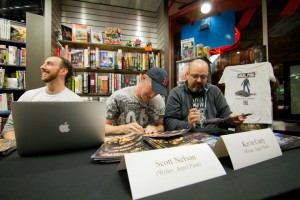On Wednesday, we launched Angel Punk Issue #1 at Things From Another World on Sandy. It was a killer party! And I particularly loved watching the guys flourish those shiny sharpies over Val’s fantastic covers. I can hardly wait until I’m the one with pen in hand, but before that happens, a whole lot more words need to get on the page. Come to think of it, the team is making me do the heavy lifting in the text production department. What’s up with that?
Anyway, at the party, I was talking to one of our early supporters and telling him about the great response we had to the transmedia presentation we gave at KidLitCon 2011. Our panel, widely talked up in the kidlit blogsphere, was called “epic” among other nice things! We also got a short write-up in School Library Journal and invitations to speak to the publishing program at Portland State University as well as the Youth Services Librarians for Multnomah county.
But back to the party… Our mystery man asked me what people were most excited about—The story? The character? The means of telling? Good question! There’s no doubt that a kick-ass heroine who’s trying to do the right thing (even if her perspective is a little warped at times) is a huge draw to the Angel Punk universe. I don’t think we’ll ever get tired of epic struggles and the hero’s journey. But among the kidlit in-crowd, the idea of interwoven yet stand-alone stories is what fires the imagination.
None of us think that the traditional book form is really going to die (in spite of dire reports) because humans love good stories well-told. What is changing is the way in which fans want to participate in the experience of the story. Here’s the traditional model: (1) troubled writer alone in garret fights madness by writing stories, (2) writer is discovered and can afford alcohol again, and (3) story travels a one-way, straight-line path to the reader’s head.
In the transmedia model, we want to make story delivery less linear and definitely not uni-directional. Angel Punk has an inner circle of creators but once the bones are in place, that circle will widen to include enthusiasts of the universe. This is a model that can evolve with changing technologies not be made obsolete by it. Books will change—how they look, how we get them, and how we read them—but good storytelling sticks around. And not all stories are best served by a traditional book. Some are so visual that comics or film are better media vehicles. Others require a distinct audio component.
Ultimately, I think the kidlit bloggers were excited about Angel Punk because it leaps beyond current forms of storytelling and promises to engage reader/fans on many levels. With that… I’m back to work. And don’t worry, I’m not fighting madness or drinking myself silly.
